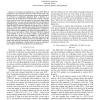Free Online Productivity Tools
i2Speak
i2Symbol
i2OCR
iTex2Img
iWeb2Print
iWeb2Shot
i2Type
iPdf2Split
iPdf2Merge
i2Bopomofo
i2Arabic
i2Style
i2Image
i2PDF
iLatex2Rtf
Sci2ools
INFOCOM
2003
IEEE
2003
IEEE
Performance anomaly of 802.11b
— We analyze the performance of the IEEE 802.11b wireless local area networks. We have observed that when some mobile hosts use a lower bit rate than the others, the performance of all hosts is considerably degraded. Such a situation is a common case in wireless local area networks in which a host far away from an Access Point is subject to important signal fading and interference. To cope with this problem, the host changes its modulation type, which degrades its bit rate to some lower value. Typically, 802.11b products degrade the bit rate from 11 Mb/s to 5.5, 2, or 1 Mb/s when repeated unsuccessful frame transmissions are detected. In such a case, a host transmitting for example at 1 Mb/s reduces the throughput of all other hosts transmitting at 11 Mb/s to a low value below 1 Mb/s. The basic CSMA/CA channel access method is at the root of this anomaly: it guarantees an equal long term channel access probability to all hosts. When one host captures the channel for a long time becau...
| Added | 04 Jul 2010 |
| Updated | 04 Jul 2010 |
| Type | Conference |
| Year | 2003 |
| Where | INFOCOM |
| Authors | Gilles Berger-Sabbatel, Franck Rousseau, Martin Heusse, Andrzej Duda |
Comments (0)

